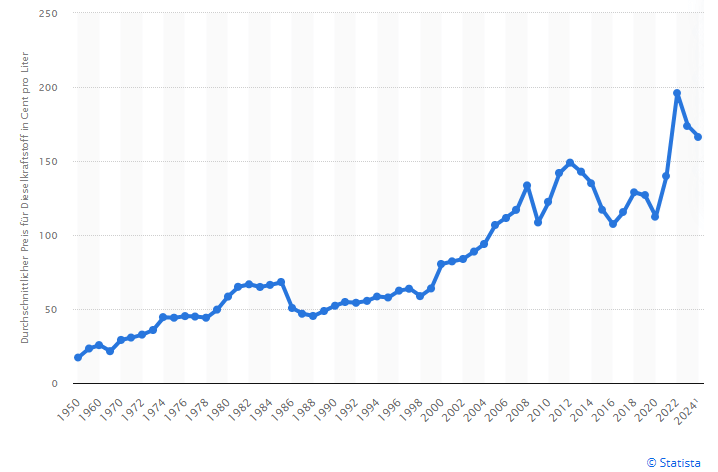Diesel Dependency Comes at a Price – Why Electrification Is the Smarter Move


The transition to emission-free propulsion is no longer just necessary to slow down climate change – it is an economic and strategic imperative. Sticking with diesel means relying on an expensive, scarce, and geopolitically unstable resource, leading to long-term dependence and ultimately paying twice. The signs point to change – those who fail to act now risk being left behind and losing their competitive edge.
Since the 1950s, diesel prices have consistently risen, from around 30 pfennigs per litre in 1950 to an average of €1.65 per litre (gross) in 2024.*

Average price of diesel fuel in Germany from 1950 to 2024 (cents per litre), source: Statista 2023
These price increases are not just due to inflation but also geopolitical tensions, limited production capacities, and political interventions. Additionally, diesel is a fossil fuel with finite reserves. Its scarcity inevitably leads to rising prices and jeopardises supply security.
The transport and logistics sector is particularly affected by these cost increases and is under increasing regulatory pressure. Global supply chains are more fragile than ever. International dependencies lead to uncertainties, supply gaps, and unpredictable price developments. The global energy market is heavily influenced by geopolitical tensions: sanctions against Russia, political instability in the Middle East, and economic policies in the US cause constant price fluctuations and uncertainties. The "America First" policy under Donald Trump, the promotion of domestic oil production, and looming trade wars could further destabilise the global market.
Historically, such developments have had profound economic impacts: The oil crises of the 1970s demonstrated how a sudden supply contraction could cause drastic price hikes. Today, it is clear: those who continue to rely on fossil fuels are making themselves dependent on an unpredictable market and will ultimately pay the price.
With the Paris Climate Agreement and national climate targets, Germany has committed to drastically reducing CO₂ emissions by 2030. The transport sector is identified as one of the key levers for achieving this goal. Diesel-powered lorries contribute significantly to these emissions, placing a major responsibility on the industry to develop new approaches to decarbonisation. The regulations for CO₂ reduction are becoming increasingly stringent.
Measures such as CO₂ pricing, stricter emission standards for commercial vehicles, and local bans on diesel vehicles are increasing pressure on the industry. An additional burden is the introduction of CO₂-based tolls for commercial vehicles, which will take effect in Germany from 2024. These toll costs are determined by a vehicle’s CO₂ emissions, significantly increasing operating costs for diesel lorries.
Those who still cling to combustion engines will end up paying twice – first for rising fuel costs and later for penalties or costly retrofits.
The path to independence from diesel is clear: electrification with self-generated power – for example, through photovoltaics (PV) and energy storage at depots – combined with the use of regionally produced wind and solar electricity. This approach allows transport and logistics companies to secure stable and predictable energy costs, gain independence from global crises, and avoid penalties. Specifically, the combination of self-generated energy, storage, and e-mobility can lead to cost savings of up to 55%.
Example Calculation: Cost Savings through PV Self-Generation, Flexible Electricity Tariffs, and Digital Energy Management.
Let’s consider an example in distribution transport involving four 40-tonne lorries operating during the day and being parked overnight.

We compare the energy costs of diesel lorries with those of an electric fleet that is not digitally controlled. In contrast, we examine an electric fleet with intelligent digital management, as offered by IO-Dynamics.

The example illustrates: An intelligently controlled e-fleet, integrating PV battery storage and charging management, is a game-changer for an economically viable, reliable, and sustainable electric fleet in transport logistics.
Diesel prices will continue to rise, political uncertainties will increase, while demand for emission-free solutions will grow. Companies that invest in electric vehicles, photovoltaics, and energy storage now – and ensure strong digital networking – will not only secure long-term stable operating costs but also strategically position themselves for the future.
In the current EU political landscape, it is unlikely that comprehensive subsidies or tax breaks for diesel will be introduced. On the contrary, the EU is pursuing the goal of reducing fossil fuel consumption and promoting the transition to renewable energy and independence.
Globally, many countries are striving for energy independence and are increasingly investing in renewable energy and e-mobility. China and India are leading the way:
China: In 2023, China accounted for 60% of the world’s newly installed renewable energy capacity. The country is on track to generate more electricity from solar power alone in the early 2030s than the United States currently consumes.
India: By October 2024, India’s total installed power capacity reached approximately 416 gigawatts, with around 40% coming from renewable sources.
Scandinavian countries such as Norway, Sweden, and Denmark are also pioneers in the use of renewable energy and the promotion of e-mobility.
These international efforts clearly show that the future of energy supply lies in renewable resources and e-mobility. Companies that invest in these technologies today will not only gain economic advantages but also make a crucial contribution to global climate protection. Some of the largest transport and logistics companies are already leading the way, proving that the technology is ready, practical, and economically attractive.
----
Learn more about cost efficiency and electrification in transport logistics in our webinar series (german language).
----
Sources: *adac.de, Additional sources: weltenergierat.de, iea.org, erneuerbareenergien.de, xpert.digital
Questions about the product?
Send an email to
Technical questions?Send an email to
Support-Tel.:
+49 461 402 142-10